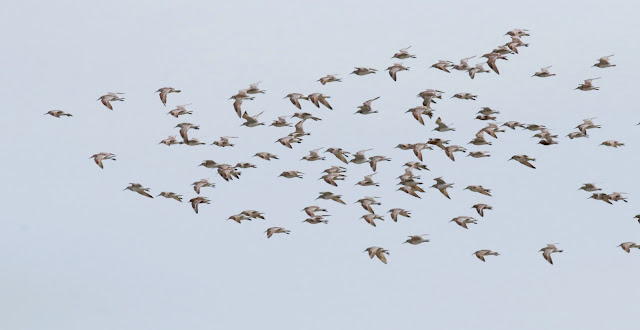According to a research, birds in the order Charadriiformes are commonly called shorebirds which include plovers (Charadriidae). Meanwhile birds in the family Scolopacidea are commonly known as sandpipers or snipes. Over here we call shorebirds as waders and they are mostly migratory birds. The month of April and May is the best time to see them before they leave for their "summer camp". This is when the males will dress to their nines.

In April recently, I had the opportunity to visit my local waders' patch which is just a 30 minutes drive away. Upon arriving, I was surprised to see a couple of Selangor birders (Bryan and Yen Yi) already gearing up for the waders. Later more birders joined us including Dr Nur Munira, her husband and Hor Kee from Penang. It was already 2pm when we reach there and the tide has already receded quite a bit.
Birders from Penang and Selangor waiting for action.
The waders could be seen resting at a nearby mangroves about 150 meters away from us but with a scope the birders can easily identify each of them.
Dr Nur Munira and her husband discussing on the possible waders which can be seen. 
Waiting for the waders to disembark from their roosting area or perhaps new arrivals.
We started with just a few waders. These Kentish Plovers were just one of them.
Kentish Plover Kentish Plover
Lesser Sand Plover
Occasionally we could see a large flock such as these Great Knots taking off.
That's a Red Knot there.
There were also some Pacific Golden Plovers
Pacific Golden Plovers and a Great Knot
Pacific Golden Plovers, Great Knot and two Red Knots
Asian Dowitchers
Great Knots and a Lesser Sand Plover
Red Knots
Since most of the waders were resting and hiding behind the mangroves, I decided to return to the same site the following day. This time I arrived just when the tide is rising.
Most waders were seen looking for a suitable landing site like these Black-bellied Plovers - previously known as Grey Plovers. There is also a Nordmann's Grenshank in the above photo (the bird above the Black-bellied plover in the bottom middle of the photo) according to our resident expert Dave Bakewell.
They can be seen flying to and fro.
More and more waders can be seen as the tide receded.
These are mainly Pacific Golden Plover which make up the 2nd largest group among the several thousands waders observed during my 2nd trip. The ones below them were Red Knots.
Pacific Golden Plovers - they numbered a few hundreds.
Bar-tailed Godwits flying in a formation like some plane squadron.
As the tide receded further more and more waders came - these are knots I believe.
They came like a swarm of bees.
If they can't find a suitable landing spot, they will fly off again and return later.
All of a sudden, a huge flock of waders emerge from the mangroves on the left from where I stood.
The flock was so thick at one time that it block the view of Penang island. What a sight !
The wave headed towards my direction.
They are mainly Lesser Sand Plover which formed the largest waders' group observed.
You can see three Ruddy Turnstones among them.
Not many Gulls were seen this time.
These are Brown-headed Gulls I believe. They are the most common gull species seen here.
Well well ! looks who's there ? it's a Kentish Plover !
Wonder where they would go while waiting for the tide to recede?
Not all waders takes off immediately to the skies. Some of them prefers to fly under the radar.
These are Common Redshanks. They formed the third largest group in this latest survey.
A late departure.
I noticed that some waders will return to check how far has the tide receded before the main flock returns. These Common Redshanks were seen doing just that.
Then more and more waders follow suit.
There were 16 Red Knots alone in the above photo as identified by Dave Bakewell.
The Ruddy Turnstones have returned too.
They were probably looking for a place to land further up.
They came back in batches most of the time.
Part of the big flock which has returned to the same spot which they have disembarked earlier. Note the tide was still high at that time but Hor Kee has told us earlier that the tides in this region will recede as fast as they rises.
Another huge wave of waders returning. Note how the tide has gone down quickly.
The waders will be leaving again soon. And by late July you can expect them to return to our shore again. Some still with their smartly adorned summer dress.
These are RNS I believe.
Here are some other birds seen around the vicinity besides the waders.A
Pacific Reef Egret has just arrived.
Looks like it has got itself a shell.
Stuck between two coconuts and a log?
We saw a number of Indian Pond Herons this time.
They criss-crossed like the waders too.
A Great Egret having no difficulty wading during high tide.
A handicapped Common Tern.
These are what the waders will take to refuel themself before departing home.
They are sea worms and they appear in hundreds. I guess that could explain why there were so many waders here although not all of them eat these worm species.
They can break up easily which makes them an easy meal for some waders.
AS THE WADERS SAY "WE WILL BE BACK SOON" SO AM I !






















































No comments:
Post a Comment